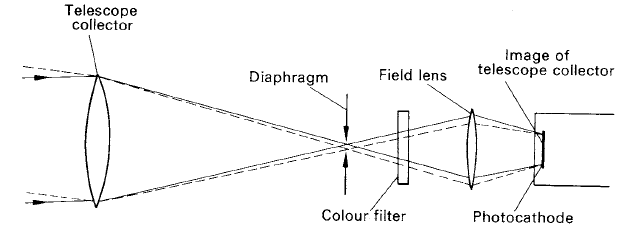


 الفيزياء الكلاسيكية
الفيزياء الكلاسيكية
 الكهربائية والمغناطيسية
الكهربائية والمغناطيسية
 علم البصريات
علم البصريات
 الفيزياء الحديثة
الفيزياء الحديثة
 النظرية النسبية
النظرية النسبية
 الفيزياء النووية
الفيزياء النووية
 فيزياء الحالة الصلبة
فيزياء الحالة الصلبة
 الليزر
الليزر
 علم الفلك
علم الفلك
 المجموعة الشمسية
المجموعة الشمسية
 الطاقة البديلة
الطاقة البديلة
 الفيزياء والعلوم الأخرى
الفيزياء والعلوم الأخرى
 مواضيع عامة في الفيزياء
مواضيع عامة في الفيزياء|
Read More
Date: 18-7-2020
Date: 3-5-2017
Date: 12-7-2020
|
Image photometry: Photoelectric photometry
In the discussion of the photomultiplier, it was pointed out that this detector, in its simplest form, responds only to the total amount of energy which falls on to its sensitive area. If a brightness picture is to be built up of an extended image or series of images, it is necessary to look at each picture point in turn. If the stars in a field are to have their brightnessesmeasured photoelectrically, it is necessary to look at each star one by one and, for this purpose, a diaphragm is placed in the focal plane of the telescope. This allows any single star to be isolated and keeps to a minimum the amount of background sky light entering the photometer.
Whereas in the case of photographic observations the plate is placed in the focal plane of the telescope, an in-focus image must not be allowed to fall on the photocathode. Any photocathode has a detecting area which is non-uniform in sensitivity and any image wander over its surface caused by poor telescope following or image motion due to seeing will generate fluctuations or noise in the output signal of the cell. To prevent such noise, a field lens or Fabry lens is provided so that the collector aperture is focused on to the cathode. A lens is chosen so that the whole of the sensitive area of the cathode is filled with the light for detection. It can be seen from the ray diagram of the simple photometer depicted in figure 1 that by imaging the collector aperture on the sensitive area, movement of the telescope’s direction related to the star or agitation of the star’s position caused by seeing does not produce movement of the patch of light over the cathode. In fact, there should be no change in the detector’s output until the deviation of the telescope’s direction is such that the diaphragm in its focal plane begins to cut off the star image. Intensity scintillation, giving fluctuations of the illumination of the telescope aperture, is not removed by the expedient of the field lens and is apparent in the cell’s output.
Provision is usually made for the insertion of colour filters which limit the spectral passband.
For ease of operation, retractable viewers are usually provided before and after the diaphragm so that the star field can be studied and particular stars chosen for measurement.The output from the photomultiplier is usually monitored by DC amplification or photon counting. A series of measurements involves recording the output signal over short but regular
integration times

Figure 1. A simple photoelectric photometer. The solid lines represent light rays when the star is in the centre of the diaphragm; the dashed lines represent light rays when the star image is at the edge of the diaphragm; the field lens prevents movement of the illuminated patch on the photocathode.
1. of the target star under investigation,
2. of some adjacent standard stars—and, to obtain a background level,
3. of a patch of sky without any stars present in the field.
As the response of the photomultiplier to the amount of light falling on it is linear, no further calibration is required and it is an easy matter to convert the measured responses into stellar magnitudes after subtracting the background signals from the sky background and the dark signal from the detector itself. The accuracy to which any measurement is made may depend on factors such as the quality of the observing site or the length of time which is spent in integrating the detector’s response but it is not unusual to be able to achieve an accuracy which is 1% or better, far superior to photographic photometry.



|
|
|
|
التوتر والسرطان.. علماء يحذرون من "صلة خطيرة"
|
|
|
|
|
|
|
مرآة السيارة: مدى دقة عكسها للصورة الصحيحة
|
|
|
|
|
|
|
نحو شراكة وطنية متكاملة.. الأمين العام للعتبة الحسينية يبحث مع وكيل وزارة الخارجية آفاق التعاون المؤسسي
|
|
|